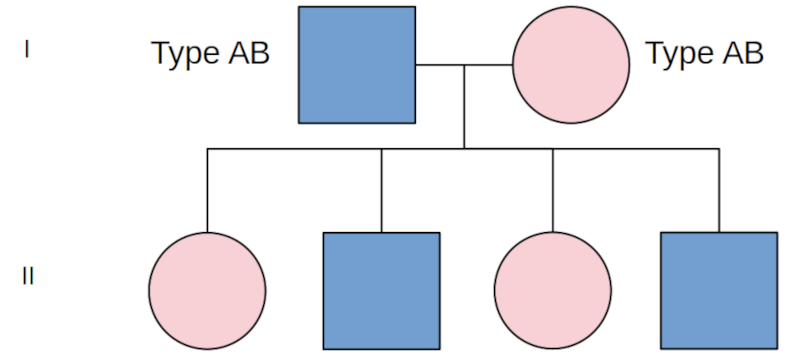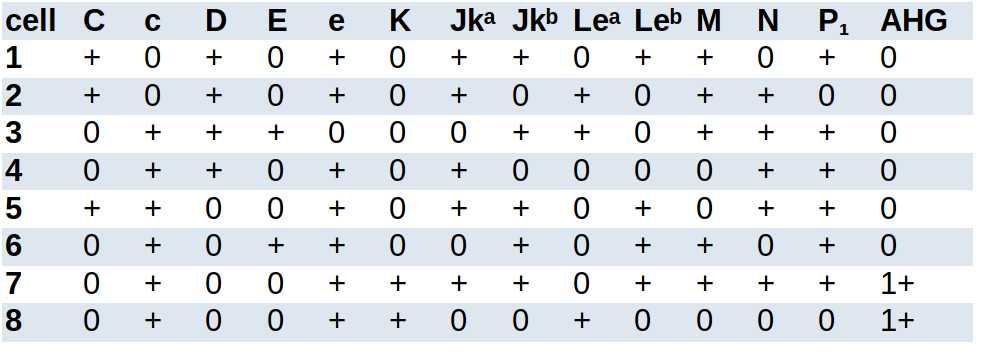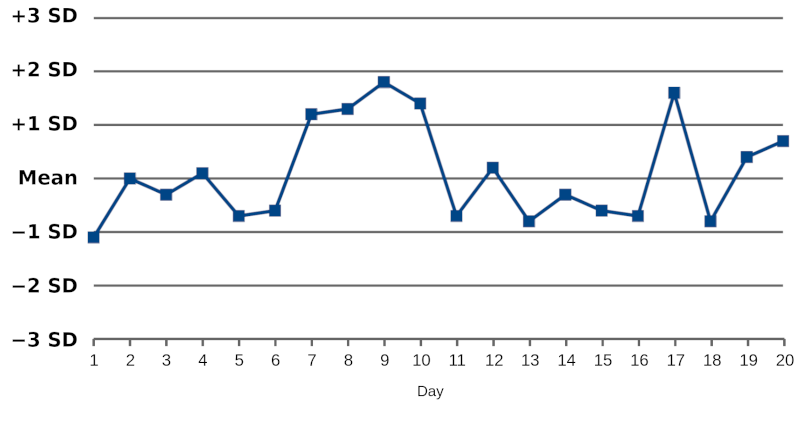 Examelot
Examelot
Report a problem
The ASCP Medical Laboratory Technician (MLT) exam assesses the knowledge required for intermediate-level medical laboratory roles. The American Society for Clinical Pathology (ASCP) administers the exam.
The exam consists of 100 multiple-choice questions and has a 2.5-hour time limit. Exam topics include blood banking, urinalysis, chemistry, hematology, immunology, microbiology, and laboratory procedures.
The exam fee is $225.
These practice questions will help prepare you for the ASCP MLT exam.
This page contains 500 practice questions divided into the seven sections of the exam: 1. Blood banking, 2. Urinalysis and other body fluids, 3. Chemistry, 4. Hematology, 5. Immunology, 6. Microbiology, and 7. Laboratory operations.
All questions have been carefully designed to mimic the questions on the real exam, to help you prepare and get a passing grade.


| anti-A | anti-B | anti-D | Rh type |
|---|---|---|---|
| + | O | + | DCe/dce |
| anti-D | anti-C | anti-E | anti-c | anti-e |
|---|---|---|---|---|
| + | + | + | + | + |
| anti-D | anti-C | anti-E | anti-c | anti-e |
|---|---|---|---|---|
| 0 | + | 0 | + | + |
| anti-D | anti-C | anti-E | anti-c | anti-e |
|---|---|---|---|---|
| 0 | 0 | + | + | + |
| anti-D | anti-C | anti-E | anti-c | anti-e |
|---|---|---|---|---|
| 0 | 0 | 0 | + | + |
| Test | Result |
|---|---|
| Urine creatinine concentration | 220 mg/dL |
| Serum creatinine concentration | 2.2 mg/dL |
| 24-hour urine volume | 1800 mL |
| Test | Result | Normal range |
|---|---|---|
| Total serum bilirubin | 14.8 mg/dL | 0.1–1.2 mg/dL |
| ALP | 132 IU/L | 44–147 IU/L |
| ALT | 739 IU/L | 19–25 IU/L |
| AST | 838 IU/L | 8–33 U/L |
| GGT | 35 IU/L | 5–40 IU/L |
| Test | Result | Normal range |
|---|---|---|
| Total serum bilirubin | 12.8 mg/dL | 0.1–1.2 mg/dL |
| ALP | 452 IU/L | 44–147 IU/L |
| ALT | 37 IU/L | 19–25 IU/L |
| AST | 45 IU/L | 8–33 U/L |
| GGT | 140 IU/L | 5–40 IU/L |

| Parameter | Result |
|---|---|
| Color | Pale yellow |
| Appearance | Cloudy |
| Specific gravity | 1.015 |
| pH | 6.0 |
| Glucose | Negative |
| Protein | 1+ |
| Bacteria | Many |
| WBC casts | Many |
| WBC/HPF | 30 |
| Test | Result |
|---|---|
| pH | 6.91 |
| PaCO₂ | 40 mmHg |
| Bicarbonate | 16 mEq/L |
| Test | Result |
|---|---|
| TSH | Normal |
| Calcium | High |
| Phosphate | Low |
| Parathyroid hormone | High |
| Test | Result |
|---|---|
| Glucose | 81 mg/dL |
| HDL cholesterol | 75 mg/dL |
| LDL cholesterol | 80 mg/dL |
| Sodium | 105 mEq/L |
| Creatinine | 0.9 mg/dL |
| Test | Result |
|---|---|
| Sodium | 150 mEq/L |
| Chloride | 90 mEq/L |
| Bicarbonate | 20 mEq/L |
| Test | Result |
|---|---|
| Sodium | 140 mEq/L |
| Glucose | 90 mg/dL |
| BUN | 28 mg/dL |
| Measured osmolality | 301 mOsm/kg |
| Test | Result |
|---|---|
| Osmolality | 290 mOsm/kg |
| Sodium | 125 mEq/L |
| Total cholesterol | 1,381 mg/dL |
| Test | Result |
|---|---|
| Total cholesterol | 160 mg/dL |
| LDL | 100 mg/dL |
| VLDL | 20 mg/dL |
| HDL | 40 mg/dL |
| Triglycerides | 150 mg/dL |
| Electrolyte | Result |
|---|---|
| Sodium | 140 mEq/L |
| Potassium | 4.3 mEq/L |
| Chloride | 65 mEq/L |
| Magnesium | 2.0 mg/dL |
| Phosphate | 3.9 mg/dL |
| Test | Result |
|---|---|
| WBC | 2.3 x 10⁹/L |
| RBC | 3.2 x 10¹²/L |
| Platelets | 35 x 10⁹ |
| Blasts in bone marrow: | 41% |
| Score | Neutrophils |
|---|---|
| 0 | 95 |
| +1 | 3 |
| +2 | 2 |
| +3 | 0 |
| +4 | 0 |
| HCT | RBC (x10¹²/L) | Hemoglobin (g/dL) | |
|---|---|---|---|
| Patient 1 | 50% | 4.6 | 14.1 |
| Patient 2 | 41% | 6.2 | 16.8 |
| Patient 3 | 38% | 4.8 | 10.6 |
| Patient 4 | 42% | 7.2 | 13.5 |
| Test | Result |
|---|---|
| Hemoglobin | 5.7 g/dL |
| Hematocrit | 25% |
| Ferritin | 736 ng/mL |
| Iron | 314 mcg/dL |
| Transferrin | 813 mg/dL |
| Transferrin saturation | 75% |
| Test | Result |
|---|---|
| Hemoglobin | 7.9 g/dL |
| Neutrophil count | 452/mm³ |
| Platelet count | 23,100/mm³ |
| Test | Result |
|---|---|
| RBC (cells/L) | 4.7×10¹² |
| WBC (cells/L) | 4.5×10⁹ |
| PLT (cells/L) | 310×10⁹ |
| Hct | 30% (normal Hct = 45%) |
| Reticulocyte count | 1.5% |
| Test | Result |
|---|---|
| Uncorrected WBC count | 30,000/uL |
| Nucleated RBC/100 WBC | 100 |
| Score | Neutrophils |
|---|---|
| 0 | 40 |
| +1 | 40 |
| +2 | 15 |
| +3 | 5 |
| +4 | 0 |
| Score | Neutrophils |
|---|---|
| 0 | 10 |
| +1 | 40 |
| +2 | 30 |
| +3 | 10 |
| +4 | 10 |
| Test | Result |
|---|---|
| Red cell count | 5.4 × 10¹²/L |
| White cell count | 6.5 × 10⁹/L |
| Platelets | 660 × 10⁹/L |
| Test | Result |
|---|---|
| RBC | 4.68×10¹²/L |
| Hemoglobin | 133 g/L |
| Hematocrit | 0.451 |
| Test | Result |
|---|---|
| RBC | 2.8 × 10¹²/L |
| WBC | 13.1 × 10⁹/L |
| Janus kinase 2 (JAK2) mutation | Positive |
| Test | Result |
|---|---|
| % lymphocytes | 30% |
| WBC | 2.5 × 10⁹ cells/L |
| Volume of microbial-rich broth (mL) | 200 | 200 | 200 | 200 | 200 | 200 | 200 |
| Amount of antimicrobial agent (mg) | 0 | 1 | 2 | 3 | 4 | 5 | 6 |
| Result | turbid | turbid | turbid | turbid | clear | clear | clear |
| Antibiotic concentration (μg/mL) | 64 | 32 | 16 | 8 | 4 | 2 | 0 |
| Result | clear | clear | clear | turbid | turbid | turbid | turbid |
| Agar | Result |
|---|---|
| Blood agar | Beta-hemolytic colonies |
| MacConkey agar | Colorless colonies |
| Cetrimide agar | Green colonies |
| Agar | Result |
|---|---|
| Blood agar | Beta-hemolytic colonies |
| MacConkey agar | Pink colonies |
| Eosin methylene blue agar | Metallic green colonies |
| Agar | Result |
|---|---|
| Blood agar | Beta-hemolytic colonies |
| MacConkey agar | No growth |
| Mannitol salt agar | Yellow colonies |
